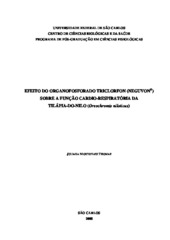Efeito do organofosforado triclorfon (Neguvon®) sobre a função cardio-respiratória da Tilápia-do-Nilo (Oreochromis niloticus)

Ver/
Fecha
2008-10-28Autor
Thomaz, Juliana Montovani
Metadatos
Mostrar el registro completo del ítemResumen
Trichlorfon (TRC) is a selective organophosphate compound (OPC) widely used to control a variety of arthropod pests, both as an agricultural insecticide and zoo vermicide. In Brazilian fish cultures, TRC is largely used to control Lernaea sp and Argulus sp, two common ectoparasites causing epizooties. The recommended doses vary from 0.1 to 1.0
mg.L-1, but farmers often apply excessive amounts of TRC in fish and agriculture farm management. The goal of this work was to evaluate the sublethal effects of TRC (0.5 mg.L-1 trichlorfon NEGUVON®, during 96 h exposure) on in vivo and in vitro cardio-respiratory function of Nile tilapia, Oreochromis niloticus. The exposure to TRC caused cardiac hypertrophy which would be probably related to the hypertensive effect of the OPCs and/or to the oxidative stress induced by TRC in the heart. TRC not only decreased oxygen uptake ( V& O2 ) values but also increased markedly the critical oxygen tension (PcO2), reducing the ability to maintain a constant O2 uptake. Gill ventilation ( G V& ) increased significantly and
progressively in both experimental groups to maintain 2 V& O during hypoxia. These increases in G V& were characterized by larger increases in the tidal volume (VT), whereas respiratory frequency (fR) changed little. A possible explanation for the reduced fR recorded for the TRC group would be a rapid effect of the OPCs in the respiratory nerves due to its anticholinesterasic effect. The lower fR induced by TRC exposure affected G V& during severe hypoxia as this group presented higher VT values, when compared to the controls (C group), only in normoxia and moderate hypoxia. The exposure to TRC significantly reduced heart rate (fH) in all the experimental PO2, when compared to control values. Both C and TRC groups maintained a constant fH and bradycardia was developed at 20 mmHg. The reason for
the early reduction in 2 V& O without hypoxic bradycardia could be the inhibition of the oxygen sensors located in the gills by OPCs, which block the hypoxic bradycardia reflex or,
alternatively, an indication that this OPC acts directly on the respiratory nerves and not via the central nervous system. The most remarkable effect of TRC exposure in heart muscle
preparations was a significant decrease in force development, when compared to C group. Increases in extracellular Ca2+ concentration caused a positive inotropic effect in both
experimental groups, but not sufficient to restore the values developed by the controls in TRC group, which indicates that extracellular Ca2+ availability is not a predominant factor to
counteract the negative inotropism caused by TRC. In both experimental groups, contractile force decreases as stimulation frequency increases, resulting in a negative force-frequency relationship. However, exposure to TRC changed the curve of maximum frequency downward due to its negative effect on force development, showing that the pumping capacity is also injured by this OPC. Taken together, the results show that TRC significantly impairs the Nile tilapia s cardio-respiratory function, reducing the species capacity to survive prolonged hypoxic conditions.